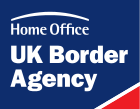This article needs additional citations for verification. (June 2012) |
| UK Border Agency | |
|---|---|
 | |
| Abbreviation | UKBA |
| Agency overview | |
| Formed | 1 April 2008 |
| Preceding agencies | |
| Dissolved | 1 April 2013 |
| Superseding agency | Border Force UK Visas and Immigration Immigration Enforcement |
| Employees | 23,500 |
| Jurisdictional structure | |
| National agency (Operations jurisdiction) | United Kingdom |
| Operations jurisdiction | United Kingdom |
| Legal jurisdiction | United Kingdom |
| Specialist jurisdictions | |
| Operational structure | |
| Headquarters | 2 Marsham Street, London, SW1P 4DF |
| Sworn members | 10,000 |
| Unsworn members | 10,000 |
| Minister responsible |
|
| Agency executive |
|
| Parent agency | Home Office |
| Facilities | |
| UKBA 42m Customs Cutters | Five |
| Planes | Yes |
| Detection dogs | Over 100 |
| Notables | |
| Programme |
|
The UK Border Agency (UKBA) was the border control agency of the Government of the United Kingdom and part of the Home Office that was superseded by UK Visas and Immigration, Border Force and Immigration Enforcement in April 2013.[1] It was formed as an executive agency on 1 April 2008 by a merger of the Border and Immigration Agency (BIA), UKvisas and the detection functions of HM Revenue and Customs. The decision to create a single border control organisation was taken following a Cabinet Office report.[2]
The agency's head office was 2 Marsham Street, London. Rob Whiteman became Chief Executive in September 2011. Over 23,000 staff worked for the agency, in over 130 countries. It was divided into four main operations, each under the management of a senior director: operations, immigration and settlement, international operations and visas and law enforcement.[3]
The agency came under formal criticism from the Parliamentary Ombudsman for consistently poor service, a backlog of hundreds of thousands of cases, and a large and increasing number of complaints.[4] In the first nine months of 2009–10, 97% of investigations reported by the Ombudsman resulted in a complaint against the agency being upheld.[5] The complainants were asylum, residence, or other immigration applicants.[5]
In April 2012, the border control division of the UKBA was separated from the rest of the agency as the Border Force. On 26 March 2013, following a scathing report into the agency's incompetence by the Home Affairs Select Committee,[6] it was announced by Home Secretary Theresa May that the UK Border Agency would be abolished and its work returned to the Home Office. Its executive agency status was removed[7] as of 31 March 2013[8] and the agency was split into three new organisations; UK Visas and Immigration focusing on the visa system, Immigration Enforcement focusing on immigration law enforcement and Border Force, providing immigration and customs law enforcement at ports of entry in the UK.[9][10]
- ^ "UK Border Agency". GOV.UK. 2013. Retrieved 27 March 2013.
- ^ Cabinet Office web site. "Security in a Global Hub – Establishing the UK's new border arrangements". Archived from the original on 7 April 2010. Retrieved 7 July 2024.
- ^ "Our organisation". UK Border Agency. 2013. Archived from the original on 25 January 2013. Retrieved 27 March 2013.
- ^ "Fast and Fair?" (PDF). Parliamentary and Health Service Ombudsman. 9 February 2010. Archived from the original (PDF) on 10 August 2016. Retrieved 8 November 2011.
- ^ a b "Ombudsman publishes report on UK Border Agency" (Press release). Parliamentary and Health Service Ombudsman. Archived from the original on 9 August 2012. Retrieved 12 April 2012.
- ^ "The work of the UK Border Agency (July-September 2012) - Conclusions and recommendations". UK Parliament. 19 March 2013.
- ^ "UK Border Agency". UK Parliament Hansard via TheyWorkForYou.com. 26 March 2013. Retrieved 8 June 2013.
- ^ "UK Border Agency's transition to Home Office" (Press release). UK Border Agency Website. 3 May 2013. Archived from the original on 10 January 2014. Retrieved 8 June 2013.
- ^ "UK Border Agency 'not good enough' and being scrapped". BBC News. 26 March 2013. Retrieved 26 March 2013.
- ^ "UK Border Agency - Our organisation". UK Border Agency. 1 April 2013. Archived from the original on 2 October 2013. Retrieved 23 October 2013.